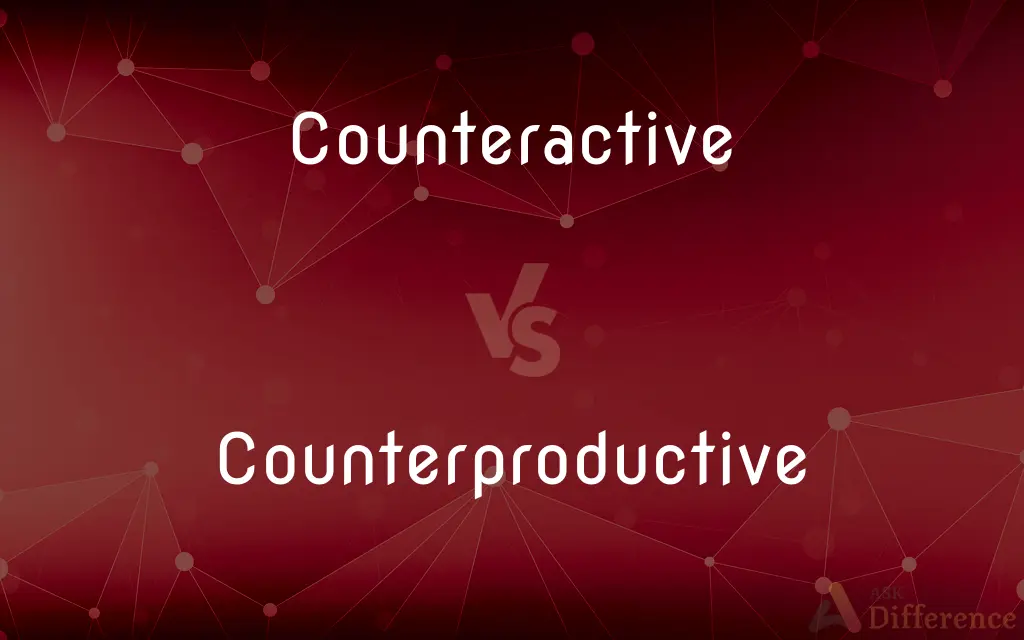Counteractive vs. Counterproductive — What's the Difference?
By Tayyaba Rehman & Urooj Arif — Updated on April 4, 2024
Counteractive measures aim to neutralize or mitigate effects, while counterproductive actions inadvertently hinder or negate desired outcomes.

Difference Between Counteractive and Counterproductive
Table of Contents
ADVERTISEMENT
Key Differences
Counteractive strategies are implemented with the intent to oppose or mitigate negative effects of a situation. These measures are typically reactive, aiming to restore balance or reduce harm. On the other hand, counterproductive actions, despite possibly being initiated with good intentions, end up creating more problems or exacerbating the situation they were meant to improve. This distinction highlights the importance of intention and outcome in evaluating strategies or actions.
While counteractive efforts are often seen in medical treatments, environmental conservation, and conflict resolution to directly neutralize threats or adverse conditions, counterproductive behaviors can be observed in workplace policies that aim to increase productivity but instead lead to employee burnout and decreased morale. The context in which these terms are applied demonstrates their practical implications and the outcomes they produce.
In the realm of personal development, adopting counteractive habits like regular exercise to combat stress is beneficial. Conversely, counterproductive habits, such as procrastination under the guise of waiting for the perfect moment to act, can derail personal progress. This comparison underscores the significance of choosing strategies that align with one’s goals.
Organizations frequently employ counteractive measures to address security breaches, implementing stricter controls and monitoring to prevent future incidents. Counterproductive measures in this context might involve overly restrictive security policies that hinder employee productivity or creativity, showcasing the fine line between safeguarding interests and impeding operational efficiency.
The environmental sector illustrates these concepts through counteractive actions like reforestation projects to combat deforestation, whereas counterproductive actions might include planting non-native species that harm the ecosystem. This example reflects the broader implications of well-intentioned actions versus their actual impact on complex systems.
ADVERTISEMENT
Comparison Chart
Definition
Measures taken to neutralize or mitigate effects
Actions that inadvertently hinder goals
Intent
To oppose or reduce negative effects
Initially aimed to improve but results in harm
Outcome
Aims to restore balance or reduce harm
Creates additional problems or exacerbates
Application Examples
Medical treatments, environmental conservation
Workplace policies leading to burnout
Long-term Effect
Often leads to restoration of balance
May derail progress or worsen situations
Compare with Definitions
Counteractive
Designed to neutralize effects.
The new legislation acts as a counteractive measure against pollution.
Counterproductive
Hindering intended goals.
Skipping meals can be counterproductive to weight loss efforts.
Counteractive
Preventing further harm.
The antidote was counteractive to the poison.
Counterproductive
Unintended negative outcomes.
The new policy was counterproductive, increasing employee turnover.
Counteractive
Restorative actions.
Counteractive practices help in ecological recovery.
Counterproductive
Actions causing more harm.
Overworking is counterproductive to overall productivity.
Counteractive
Mitigating adverse conditions.
Counteractive steps are crucial in crisis management.
Counterproductive
Exacerbating problems.
Aggressive negotiations were counterproductive, leading to conflicts.
Counteractive
Acting against or opposing.
Counteractive forces were deployed to manage the outbreak.
Counterproductive
Detrimental to progress.
Counterproductive strategies can derail a project.
Counteractive
To oppose and mitigate the effects of by contrary action; check.
Counterproductive
Tending to hinder rather than serve one's purpose.
Counteractive
That counteracts
Counterproductive
More of a hindrance than a help.
Counteractive
Tending to counteract.
Counterproductive
Tending to hinder the achievement of a goal
Counteractive
One who, or that which, counteracts.
Counteractive
Opposing or neutralizing or mitigating an effect by contrary action
Common Curiosities
How can a measure be counterproductive?
A measure can be counterproductive if it inadvertently causes more problems than it solves or worsens the situation it was intended to improve.
What is an example of a counterproductive action?
Implementing overly strict rules that lead to decreased employee morale is an example of a counterproductive action.
What does counteractive mean?
Counteractive refers to actions taken to neutralize or mitigate the effects of something negative.
Can an action be both counteractive and counterproductive?
While rare, an action can initially seem counteractive by addressing a specific issue but may become counterproductive if it leads to unforeseen negative consequences.
How can organizations avoid counterproductive measures?
Organizations can avoid counterproductive measures by conducting thorough impact analyses and seeking diverse perspectives before implementation.
What is the key difference between counteractive and counterproductive actions?
The key difference lies in their outcomes; counteractive actions aim to mitigate harm, while counterproductive actions end up causing more harm than good.
How does timing affect the effectiveness of counteractive measures?
Effective timing is critical; delayed counteractive measures might be less effective or even irrelevant.
Why are counterproductive actions often initiated?
They are usually initiated with good intentions to solve a problem but lack foresight or understanding of the situation's complexities.
Are counteractive measures always effective?
Not always; their effectiveness depends on the appropriateness of the response and the context in which they are applied.
Can counterproductive actions be corrected?
Yes, through recognition of their detrimental effects and swift implementation of more effective strategies.
What is a common misconception about counterproductive actions?
A common misconception is that counterproductive actions are always obvious; sometimes, their negative impacts only become clear over time.
Why is it important to recognize counterproductive behaviors?
Recognizing counterproductive behaviors is essential for corrective action and avoiding further harm.
What role does intention play in distinguishing between counteractive and counterproductive?
Intention is crucial; counteractive actions are intended to mitigate negative effects, whereas counterproductive actions, despite intentions, result in negative outcomes.
Can personal habits be counterproductive?
Yes, personal habits can be counterproductive if they hinder personal growth or goal achievement, despite being intended to help.
How do counteractive measures contribute to problem-solving?
They directly address and neutralize the negative aspects of a problem, contributing to a solution.
Share Your Discovery

Previous Comparison
Counseling vs. Consultation
Next Comparison
Haul vs. DragAuthor Spotlight
Written by
Tayyaba RehmanTayyaba Rehman is a distinguished writer, currently serving as a primary contributor to askdifference.com. As a researcher in semantics and etymology, Tayyaba's passion for the complexity of languages and their distinctions has found a perfect home on the platform. Tayyaba delves into the intricacies of language, distinguishing between commonly confused words and phrases, thereby providing clarity for readers worldwide.
Co-written by
Urooj ArifUrooj is a skilled content writer at Ask Difference, known for her exceptional ability to simplify complex topics into engaging and informative content. With a passion for research and a flair for clear, concise writing, she consistently delivers articles that resonate with our diverse audience.














































